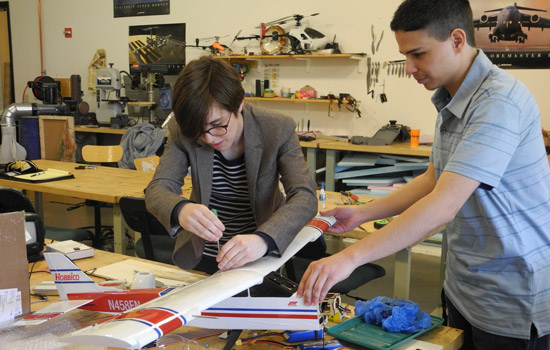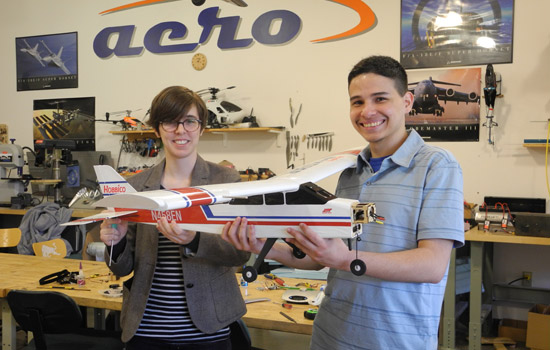Planes, drivetrains and automobiles at Imagine RIT
Student exhibitors feature aerospace and automotive innovations
Michelle Cometa
Aurora Kiehl and Dennis Vega reveal the unmanned aerial vehicle they will display at the Imagine RIT: Innovation and Creativity Festival on May 4. The engineering students were part of a five-person multidisciplinary senior design team.
Some of today’s groundbreaking technologies are being developed for use in the sky.
When the radio-controlled aircraft designed by five engineering students takes flight over RIT at this year’s Imagine RIT: Innovation and Creativity Festival, it will be equipped with some of the latest technology to collect aerial images and relay information to ground controllers in real time.
The Unmanned Aerial Vehicle Base Station Project incorporates telemetry, guidance and fault detection systems on unmanned aircraft. This is important technology as more and more unmanned aerial vehicles are being used to support disaster rescue and recovery efforts as well as military reconnaissance, says Dennis Vega, a fifth-year computer engineering student from Elizabeth, N.J.
“People will know what they are dealing with through visual feeds before sending people into the field,” he adds. He and members of the senior design team that includes Aurora Kiehl, Scott Neuman, Jeremie Snyder and Stephen Wess will demonstrate the aircraft’s technological capabilities during the festival in the field north of N Lot and the Gordon Field House.
The team is part of a larger project overseen by Jason Kolodziej, associate professor of mechanical engineering in RIT’s Kate Gleason College of Engineering, to support researchers at RIT’s Chester F. Carlson Center for Imaging Science who have been at the forefront of data acquisition through aerial photo and video imaging.
Kolodziej’s students worked to integrate on-board measurement and telemetry systems, and this year added a seeded fault system, a means to detect structural damage that could impact flights, says Kiehl, a fifth-year mechanical engineering student from Fairfax, Va., who helped construct the different failure systems inside the aircraft.
The team programmed an in-flight problem, part of the wing would detach so that onboard accelerometers could detect vibrations, Kiehl explains. That information could then be relayed to the ground controllers.
As the U.S. looks to increase use of unmanned aerial vehicles, or drones, there is still some skepticism about their value. But both students see the technology as cost effective and a way to safely provide important information to recovery teams and military personnel.
“There’s a general fear in the population that with UAVs, no one is controlling them or they are spying on us,” says Kiehl. “But we can show the general public that we’re students, we’re doing this with good intentions, and that the avionics community is very passionate about this work and its benefits.”
The team’s exhibit is only one of many featuring how student-engineers and faculty-researchers are improving upon engine designs and alternative energies for those engine systems. While the unmanned aerial vehicles, model racecars, snowmobiles or Formula racecars are appealing, they are also serious designs that incorporate start-of-the art technologies.
Here are few that can be experienced at Imagine RIT:
- See live trials of the autonomous 1/18-scale cars created by computer engineering students for the Freescale Cup, a global competition hosted by the international semiconductor company. Time trials will take place throughout the day at Clark Gym.
- Graduate research students in mechanical engineering will be available to discuss general questions about alternative energy vehicles and the possibility of increased green energy through cutting-edge research in fuel cells for automotive applications. Novel techniques being used to improve the efficiency and performance of fuel cells and the physics behind them will be on display throughout the day at James E. Gleason Hall.
- Meet the SAE Clean Snowmobile Team, one of RIT’s newest competitive teams, in the quad area between CIMS and the Golisano Institute for Sustainability. The team just competed in its first national engineering design challenge and will discuss the competition as well as how the group reengineered an existing snowmobile to reduce emissions and noise.
- The RIT Formula SAE Racecar team will unveil the new racecar for the 2013 competition season at Stage 2 in the Simone Circle at 11 a.m. The racecar is entirely designed, manufactured and tested by the team; it features a turbo-charged engine, carbon-fiber chassis, aerodynamic wings and many other advanced, student-designed features.
 Aurora Kiehl and Dennis Vega put the finishing touches on an unmanned aerial vehicle they will display at the Imagine RIT: Innovation and Creativity Festival on May 4. Michelle Cometa
Aurora Kiehl and Dennis Vega put the finishing touches on an unmanned aerial vehicle they will display at the Imagine RIT: Innovation and Creativity Festival on May 4. Michelle Cometa















